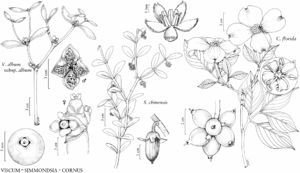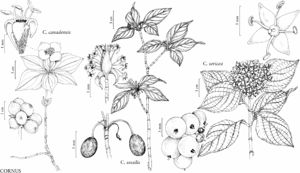Cornaceae
Herbs, shrubs, or trees, perennial, deciduous, synoecious [dioecious]; hairs unbranched or 2-armed (occasionally 1 arm absent). Leaves usually opposite, sometimes alternate, simple; stipules absent; petiole usually present, sometimes absent; blade margins entire; venation pinnate (eucamptodromous). Inflorescences axillary or terminal, cymes, umbels, or capitula. Flowers bisexual [unisexual]; perianth and androecium epigynous; hypanthium completely adnate to ovary; sepals 4 (–5), distinct or slightly connate; petals 4 (–5), distinct, valvate; nectary present, intrastaminal; stamens 4 (–5), distinct, free; anthers dehiscing by longitudinal slits; pistil 1, [1–] 2 [–4] -carpellate, ovary inferior, [1–] 2 [–4] -locular, placentation apical; ovules 1 per locule, apotropous to epitropous; style 1; stigmas 2. Fruits drupes, rarely fused into a syncarp. Seeds 1 (–2) per fruit.
Distribution
North America, Mexico, Central America, n, w South America, Eurasia, Africa, predominately northern boreal and temperate regions, also high elevations in subtropical and tropical regions
Discussion
Genus 1, species ca. 60 (20 species in the flora).
Delimitation of Cornaceae has varied over the years, with many treatments circumscribing the family broadly to include Nyssa and several small Asian genera along with Cornus (for example, Xiang Q. Y. et al. 1998). DNA sequence data from intensive taxon sampling support narrower circumscription, with Cornus as the sole member of the family and sister to the Asian Alangiaceae de Candolle (Xiang et al. 2011); that treatment is followed here. Aucuba, sometimes included in Cornaceae, is here placed in Garryaceae.
Selected References
None.

